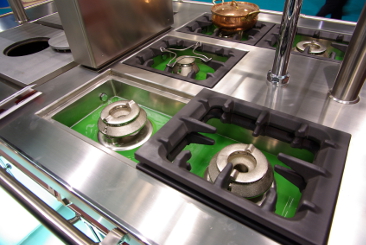|
|
| Tips for Proper Sanitation in Commercial Kitchen Facilities |
| By Robert Kravitz, President AlturaSolutions |
| Published: 03/17/2014 |
 In August 2012, about 350 inmates of nearly 900 in one Arkansas correctional facility were placed in isolation due to illness. Most were held for three to five days before prison officials decided they were well enough to join the other inmates. It was later discovered that the chicken salad served over the weekend was the culprit.
In August 2012, about 350 inmates of nearly 900 in one Arkansas correctional facility were placed in isolation due to illness. Most were held for three to five days before prison officials decided they were well enough to join the other inmates. It was later discovered that the chicken salad served over the weekend was the culprit.
As most correctional administrators know, what happened in this, the Tucker Unit of the state’s prison system, may be rare but not unheard of. Just as we hear stories of patrons becoming ill after dining in a restaurant, so it can happen in any facility involved in processing or cooking large amounts of food. While we do not know exactly what caused the chicken salad to spoil, we do know that correctional administrators can take steps to ensure their kitchens are as clean and sanitary as possible. Basic but thorough sanitation of kitchen facilities is the first step, and one of the most crucial, in maintaining the health of all working and living in a correctional facility. One of the early considerations involves selecting the correct and most effective cleaning chemicals to use in the kitchen, according to Jennifer Meek, with Charlotte Products, which manufactures food service products specifically for cleaning and maintaining commercial kitchens. “Selecting the correct cleaning chemicals is not something you want to do on your own. This requires a team approach and most importantly, working with a distributor or chemical manufacturer representative that is astute in commercial kitchen maintenance.” Meek adds that chemicals must always be properly diluted in order to work effectively. “Too much [degreaser, sanitizer, or floor cleaner] can cause corrosion of floors, metal items, etc., and too little may not have the performance or effectiveness necessary.” She suggests that correctional administrators use autodilution systems that properly dilute chemicals or, if using a wall unit that is hooked up to a water connection or faucet, adjust the system so that it meets the chemical dilution parameters recommended by the manufacturer. Among her other suggestions to help enhance sanitation and cleaning in a correctional facility kitchen are the following:
“It is also very important to remember to clean those pieces of equipment that are used throughout the day in a commercial kitchen,” adds Meek. “Some items like grills and ovens are used continuously and may escape proper cleaning. The best way to handle this is to have a schedule—for instance, all grills are cleaned at 10 a.m. and at 2 p.m. each day—so this important step is not forgotten.” As mentioned earlier, Meek also recommends that correctional facilities work with company representatives or distributors that are well versed on commercial kitchen cleaning. “These people often attend seminars and educational programs on how to properly clean commercial kitchens. . . . View these people as walking commercial cleaning encyclopedias that can help keep your kitchen clean and healthy.” Robert Kravitz is a frequent writer for the professional cleaning, building, and heathcare industries. He may be reached at robert@alturasolutions.com |
Comments:
Login to let us know what you think
MARKETPLACE search vendors | advanced search

IN CASE YOU MISSED IT
|


Thanks a lot for sharing these proper sanitation tips with us today. I am working for one of the tops furikake seasoning companies, and we need to keep our kitchens sanitized properly. Our kitchens will be cleaner now.
There are vacuum cleaners of various size and plan as ordinary new thing knows about the market and the model gets supplanted. The vacuum cleaners were prior with a development pack which amassed the development in the wake of cleaning at any rate it was required to buy the development sack over and over. These days the vacuum cleaners are bagless and are positive. The vacuum cleaners go with different sizes and part so promise Top vacuum cleaner you picked the cleaner that encourages your necessities.
Proper sanitation should be done in all the commercial kitchen facilities, and if you don't get Nuwave air fryer, then it will be a disappointing thing. You should always strive for proper sanitation.
Impulse buying. You shouldn't just buy the first juicer that you see. A juicer should be looked at as juicing bodybuilding an investment (for good health, that is), and in order to find the right one, you should have several options to choose from and choose the one that will give you the most benefit.
Yes, your suggestions will definitely enhance sanitation and cleaning in a correctional facility kitchen. If you add Kitchen Benchtops, kitchen will look awesome.
good content as always. Please write something about restaurant supply for readers.
Robert Kravitz thank you very much for this post on tips for proper sanitation in commercial Kitchen facilities. I prefer going for the Kitchens Melbourne too. I look forward to more on this though, keep sharing.